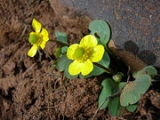
Ranunculus glaberrimus
Encyclopedia
Ranunculus glaberrimus (Sagebrush Buttercup) is a small plant native to interior western North America
, from central British Columbia
east to southern Saskatchewan
, southwest to northeastern California
, and southeast to northern New Mexico
. It prefers habitat near junipers (Juniperus occidentalis
) and sagebrush (Artemisia tridentata
) in damp ground.
It is a herbaceous
perennial plant
growing to 5–26 cm tall. The leaves
are oval, sometimes with rounded teeth at the end. The flower
s are bright glossy yellow, usually with five petals but sometimes ten or more, the petals 6–15 mm long and 4–8 mm broad. It is among the first flowers to bloom after the snow has melted.
Like many members of the buttercup family
to which is belongs, it is somewhat poison
ous.
North America
North America is a continent wholly within the Northern Hemisphere and almost wholly within the Western Hemisphere. It is also considered a northern subcontinent of the Americas...
, from central British Columbia
British Columbia
British Columbia is the westernmost of Canada's provinces and is known for its natural beauty, as reflected in its Latin motto, Splendor sine occasu . Its name was chosen by Queen Victoria in 1858...
east to southern Saskatchewan
Saskatchewan
Saskatchewan is a prairie province in Canada, which has an area of . Saskatchewan is bordered on the west by Alberta, on the north by the Northwest Territories, on the east by Manitoba, and on the south by the U.S. states of Montana and North Dakota....
, southwest to northeastern California
California
California is a state located on the West Coast of the United States. It is by far the most populous U.S. state, and the third-largest by land area...
, and southeast to northern New Mexico
New Mexico
New Mexico is a state located in the southwest and western regions of the United States. New Mexico is also usually considered one of the Mountain States. With a population density of 16 per square mile, New Mexico is the sixth-most sparsely inhabited U.S...
. It prefers habitat near junipers (Juniperus occidentalis
Juniperus occidentalis
Juniperus occidentalis is a shrub or tree native to the western United States, growing in mountains at altitudes of 800-3,000 m .-Description:...
) and sagebrush (Artemisia tridentata
Artemisia tridentata
Artemisia tridentata is a shrub or small tree from the family Asteraceae. Some botanists treat it in the segregate genus Seriphidium, as S. tridentatum W. A. Weber, but this is not widely followed...
) in damp ground.
It is a herbaceous
Herbaceous
A herbaceous plant is a plant that has leaves and stems that die down at the end of the growing season to the soil level. They have no persistent woody stem above ground...
perennial plant
Perennial plant
A perennial plant or simply perennial is a plant that lives for more than two years. The term is often used to differentiate a plant from shorter lived annuals and biennials. The term is sometimes misused by commercial gardeners or horticulturalists to describe only herbaceous perennials...
growing to 5–26 cm tall. The leaves
Leaf
A leaf is an organ of a vascular plant, as defined in botanical terms, and in particular in plant morphology. Foliage is a mass noun that refers to leaves as a feature of plants....
are oval, sometimes with rounded teeth at the end. The flower
Flower
A flower, sometimes known as a bloom or blossom, is the reproductive structure found in flowering plants . The biological function of a flower is to effect reproduction, usually by providing a mechanism for the union of sperm with eggs...
s are bright glossy yellow, usually with five petals but sometimes ten or more, the petals 6–15 mm long and 4–8 mm broad. It is among the first flowers to bloom after the snow has melted.
Like many members of the buttercup family
Ranunculaceae
Ranunculaceae are a family of about 1700 species of flowering plants in about 60 genera, distributed worldwide....
to which is belongs, it is somewhat poison
Poison
In the context of biology, poisons are substances that can cause disturbances to organisms, usually by chemical reaction or other activity on the molecular scale, when a sufficient quantity is absorbed by an organism....
ous.

